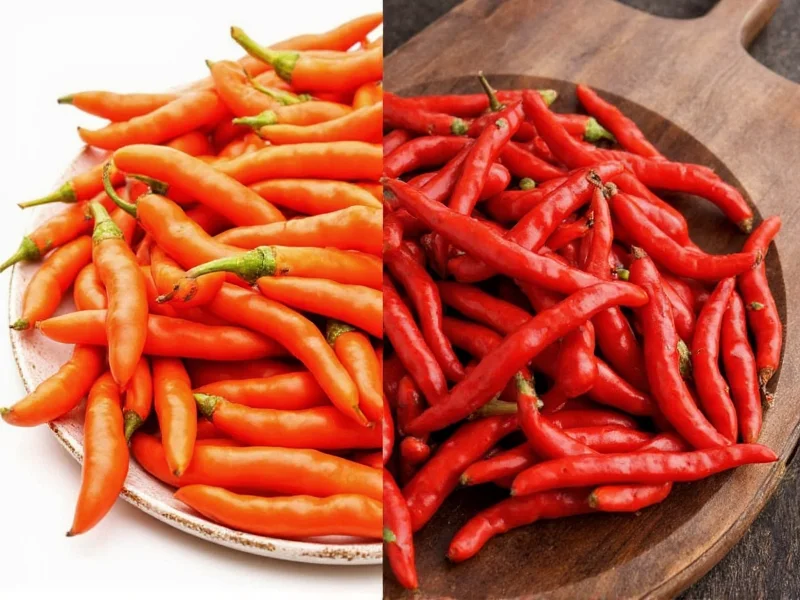Understanding the distinction between chili peppers and cayenne peppers resolves common kitchen confusion and improves culinary decision-making. Many home cooks mistakenly treat these terms as interchangeable, leading to unexpected heat levels in dishes. This comprehensive guide clarifies the botanical, culinary, and practical differences between these frequently confused ingredients.
Botanical Classification Explained
The term "chili pepper" refers to any fruit from the Capsicum genus, which includes over 30 species and thousands of cultivars. This broad category spans everything from mild bell peppers (Capsicum annuum) to extremely hot ghost peppers (Capsicum chinense). Cayenne pepper, however, specifically denotes a particular variety of Capsicum annuum characterized by its long, slender shape and vibrant red color when mature.
When discussing cayenne pepper in culinary contexts, we're usually referring to either:
- Fresh cayenne peppers - the actual fruit
- Cayenne pepper powder - made from dried cayenne peppers
Heat Level Comparison
Heat measurement using the Scoville scale reveals significant differences between general chili peppers and specific cayenne varieties:
| Pepper Type | Scoville Heat Units | Heat Relative to Cayenne |
|---|---|---|
| Cayenne pepper | 30,000-50,000 SHU | Baseline |
| Jalapeño (common chili) | 2,500-8,000 SHU | 6-12x milder |
| Serrano (common chili) | 10,000-23,000 SHU | 2-3x milder |
| Habanero (common chili) | 100,000-350,000 SHU | 2-7x hotter |
This comparison shows why substituting generic "chili powder" (often made from milder peppers) for cayenne can dramatically alter a dish's heat profile. The difference between chili pepper and cayenne pepper heat level represents one of the most crucial distinctions for cooks.
Flavor Profiles and Culinary Applications
Beyond heat, these peppers offer distinct flavor characteristics:
- Cayenne peppers deliver a sharp, immediate heat with subtle berry-like undertones and minimal sweetness. Chefs use them when seeking clean, straightforward heat without competing flavors.
- General chili peppers encompass vastly different flavor profiles - from the grassy notes of serranos to the fruity complexity of habaneros. Even within the Capsicum annuum species (which includes both cayenne and jalapeños), flavor variations are substantial.
Culinary professionals select between cayenne pepper and other chili varieties based on specific recipe requirements. Cayenne works best when you want pure heat without altering the dish's fundamental flavor profile, while other chili peppers contribute distinctive tastes alongside their heat.
Physical Characteristics Comparison
Visually distinguishing these peppers prevents grocery store confusion:
- Cayenne peppers typically grow 2-5 inches long, with a thin, tapered shape resembling a curved bird's beak. They mature from green to vibrant red.
- Other chili peppers display enormous variety - from the blocky shape of poblanos to the lantern-like form of bell peppers. Even among hot varieties, shapes differ significantly (e.g., the stubby tabasco pepper vs. the elongated Thai chili).
Substitution Guidance: When to Use Which
Understanding the difference between cayenne pepper and chili powder is essential for successful substitutions:
- Substituting cayenne for chili powder: Use 1/4 to 1/2 teaspoon cayenne for every tablespoon of chili powder, as cayenne is significantly hotter. This works best in dishes where additional heat is acceptable.
- Substituting chili powder for cayenne: Use 2-3 tablespoons chili powder per 1/4 teaspoon cayenne. Note this adds other flavors (like cumin or garlic) commonly included in chili powder blends.
- For authentic cayenne flavor: No perfect substitute exists, but crushed red pepper flakes (made from various chili types) offer similar heat with different flavor notes.
Many cooks wonder about the difference between cayenne pepper and red pepper flakes - while both provide heat, red pepper flakes typically contain a mix of辣椒 varieties (often including cayenne), creating a more complex heat profile.
Nutritional Comparison
Both provide capsaicin (the compound responsible for heat) with associated health benefits, but proportions differ:
- Cayenne contains higher concentrations of capsaicin per volume due to its intense heat
- All chili peppers provide vitamin C, vitamin A, and antioxidants
- The difference between chili pepper and cayenne pepper nutrition is primarily quantitative rather than qualitative - cayenne simply delivers more capsaicin and related compounds in smaller quantities
Common Misconceptions Clarified
Several persistent myths confuse home cooks:
- Myth: Cayenne pepper and red pepper flakes are identical
Reality: Red pepper flakes typically contain a blend of dried chili varieties, while cayenne refers specifically to one variety - Myth: "Chili powder" always contains cayenne
Reality: Most commercial chili powders use milder peppers like ancho or New Mexico varieties - Myth: The terms can be used interchangeably in recipes
Reality: Substituting one for the other without adjustment often results in dishes that are either too mild or uncomfortably hot
Practical Kitchen Guidance
When following recipes that specify either ingredient, consider these professional tips:
- For authentic Louisiana-style hot sauce, use cayenne peppers specifically
- When making chili con carne, traditional recipes call for chili powder (not cayenne) as the primary seasoning
- For precise heat control in sauces, cayenne powder offers more consistent results than variable fresh chili peppers
- When growing your own, remember that cayenne requires specific conditions different from many other chili varieties
Understanding the precise difference between chili pepper varieties and specifically cayenne pepper prevents culinary disasters and enhances flavor development. This knowledge represents an essential component of professional cooking technique that home chefs can easily master.











 浙公网安备
33010002000092号
浙公网安备
33010002000092号 浙B2-20120091-4
浙B2-20120091-4